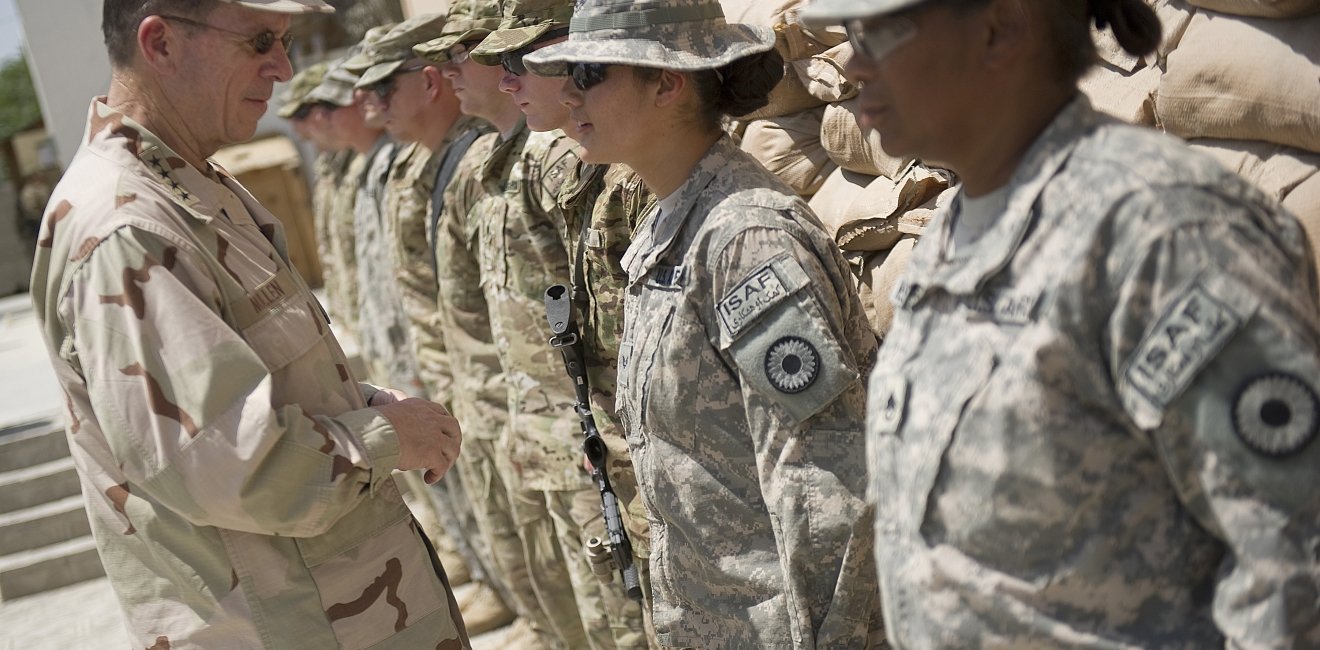Who's On Point?...SHE IS!
Lt Colonel Michael Miles, United States Air Force Fellow at the Wilson Center, comments on the Defense Department's recent decision to allow women to serve in all military combat positions.
Lt Colonel Michael Miles, United States Air Force Fellow at the Wilson Center, comments on the Defense Department's recent decision to allow women to serve in all military combat positions.

[[{"fid":"51466","view_mode":"default","fields":{"field_file_image_alt_text[und][0][value]":"Female Soldiers, International Security Assistance Force ","field_file_image_title_text[und][0][value]":"","field_file_source[und][0][value]":"","field_file_caption[und][0][value]":""},"type":"media","attributes":{"alt":"Female Soldiers, International Security Assistance Force ","height":"1080","width":"1920","class":"media-element file-default"}}]]America has been waiting. In the two hundred and forty year history of US combat forces, women have remained excluded from ground force combat positions. However, in a landmark announcement made this month, Secretary of Defense Ash Carter declared all US combat positons open to women. In the Defense Department announcement, Secretary Carter stated, “they’ll be allowed to drive tanks, fire mortars, and lead infantry soldiers into combat. They’ll be able to serve as Army Rangers and Green Berets, Navy SEALs, Marine Corps infantry…”
While this monumental and drastic policy change is crucial to the advancement of US force capability, it is worth noting that it is the culmination of a long series of reforms aimed at integrating women into all positions within the US military. Historically, women have been an integral part of the armed forces. Serving primarily as nurses or support personnel, women have shined in complex, physically demanding jobs. In WWII, women served as WASP pilots and assembled military hardware in factories across America. In the decades after, female military roles have broadened in their scope and focus and have proven invaluable to US military operations at home and abroad.
Women have also served in non-infantry combat roles for decades. Women in the Air Force have served as combat pilots for over twenty-two years, and women in the Navy have served aboard surface warships since the 1970s. As witnessed in Iraq and Afghanistan, counterterrorism operations and non-traditional warfare require a large number of skilled interpreters and have put women in combat situations time and time again.
I think for women in combat to achieve equality within the military institution is a great step forward. This type of state feminism has benefited women across cultures.
-Fatima Sadiqi, Fellow, Middle East Program
There are countless benefits to opening all combat roles to women. First, is the increase in potential recruits who can perform specific combat duties. This change provides service leaders the opportunity to pick the absolute best for each career field, whether it be snipers, tank drivers, or amphibious assault troops – the best will rise to the top and America’s combat power will increase. Additionally, having females in combat roles changes the paradigm within the services regarding gender roles and team dynamics. The machismos of combat forces will evolve and positive changes to the organizational climate will make teams more productive and cohesive.
We have seen this first hand in the Air Force. Women have been integral to Air Force operations for decades, serving in critical career fields like intelligence, aircraft maintenance, even flying combat missions. Take Jeannie Leavitt as an example, the first female Air Force combat pilot. She earned her wings in 1993, and went on to fly over 300 combat hours in F-15E Strike Eagles during Operations Enduring Freedom and Iraqi Freedom. She paved the way for some of the Air Force’s finest.
Another stellar example is retired Colonel Martha McSally, now a congresswomen from Arizona. Congresswoman McSally was an outstanding Air Force Academy cadet and received numerous accolades throughout her Air Force career. Not only was she the first woman to fly in combat, she was also the first woman to command a fighter squadron in 2001. Today, female fighter pilots are common in Air Force squadrons and are among the Air Forces’ highest caliber.
Thanks to the bold and intrepid decision by Secretary Carter, each of the services will benefit from having women in combat roles. The leadership ranks of each branch will swell with combat-proven women who will make organizational decisions with first-hand experience. It is a win-win for service leadership and all service members.
Regardless of the remaining gender-related issues existing in society, allowing women to serve in combat roles is the right direction and will have a positive reflection in the civilian world. This is also not the first time the military has taken the lead on difficult and decisive social issues. President Truman’s 1948 Executive Order 9981 desegregated the military and paved the way for the passage of the 1964 Civil Rights Act. One can only envision the positive cascading effects that last week’s decision will have on our society’s gender role perceptions and misconceptions.
Allowing women to access all military professions is a true understanding of gender mainstreaming. Both men and women should be given the space for self-actualization and the opportunity to choose their position in life. Unfortunately, Ukraine has not achieved this stage of free self-actualization. Although many women have gone to war, on paper they are officially listed at cooks and seamstresses, despite having served as tank commanders, snipers, and scouts.
- Ella Lamakh, Fullbright-Kennan Research Scholar
Although the DOD has already promoted numerous women to the rank of four-star general, all have been from non-combat positions. From 2016 and beyond, all high-ranking military positions will become more competitive and leadership throughout the ranks will be reflective of the US society at large. This author has had the privilege of serving numerous female aircraft maintenance and support officers. Women such as Linda Medler, Kathryn Johnson, Terry Gabreski, Judith Fedder, and Janet Wolfenbarger, have all been promoted to General officer ranks and have positively contributed to the units they led. They were successful commanders and leaders in their own right. As evidence has shown, gender is utterly irrelevant when it comes to mission accomplishment. It is this enduring premise that makes the DOD’s recent decision an obvious one.
Secretary Carter explained, "the important factor in making my decision was to have access to every American who could add strength to the joint force,” -- clearly stating the DOD’s ultimate deciding factor in making this change. In the coming months, America will watch with anticipation as each branch submits their plans for gender integration.
When accounting for the excitement this policy change brings, it is important to remember that equal opportunity will not necessarily equate to equal representation for women in the armed forces. Merit-based promotion is still the bottom line, but now men will have to compete with women for all top leadership positions. Without a doubt, our military will receive a boost in military fighting power as a result female participation in previously off-limit positions. With national security at the focal point of our nation’s agenda, one can be certain that increased force diversification will provide additional guarantees on the security of American citizens. Aim high sisters in arms!


The Global Women’s Leadership Initiative has hosted the Women in Public Service Project at the Wilson Center since June, 2012. The Women in Public Service Project will accelerate global progress towards women’s equal participation in policy and political leadership to create more dynamic and inclusive institutions that leverage the full potential of the world’s population to change the way global solutions are forged. Read more



